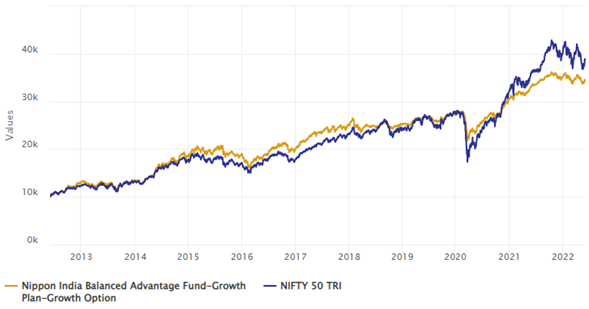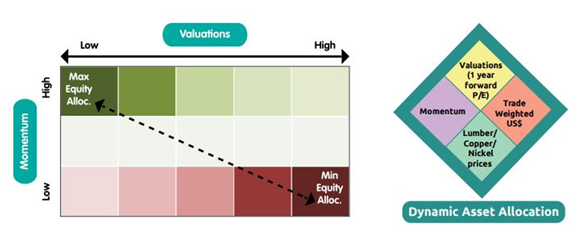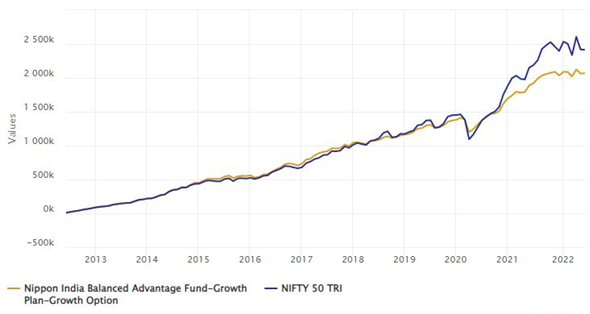Nippon India Balanced Advantage Funds: One of best performing balanced advantage funds in the last 10 years

What are Balanced Advantage Funds?
Balanced Advantage Funds, also known as Dynamic Asset Allocation Funds, are hybrid mutual funds which manage their asset allocation dynamically between equity and debt. The asset allocation will change depending on market conditions using quantitative asset allocation models.
You may like to read in detail what are Balanced Advantage Funds?
How Balanced Advantage Funds work
- Equity: This is the un-hedged equity exposure of the fund. Net equity allocation is determined by a quantitative dynamic asset allocation model based on market conditions.
- Fixed Income: Fixed income allocation is determined by the asset allocation model but is usually capped at 35% to ensure equity taxation.
- Hedging: This is the fully hedged equity component which is not exposed to market risks. Hedging reduces the net equity exposure and at the same time, helps to keep the gross equity exposure above 65%, which enables equity taxation.
Benefits of Balanced Advantage Funds
- Behavioral biases affect investor returns. Instead of “buying low and selling high” investors usually buy when market is high, thinking it will go higher. Similarly, investors sell when market is low, thinking it will fall even lower.
- Balanced advantage funds have an analytical investment approach using quantitative asset allocation model. Dynamic asset allocation models increase equity allocation / decrease debt allocation when valuations are low and decrease equity allocation / increase debt allocation when valuations are high.
- Balanced advantage funds are able to implement “buy low, sell high” because they strictly follow model based investing without any human biases.
- Balanced advantage funds usually have low equity allocations at market peaks and therefore, have relatively lower downside risks in market corrections. These funds can provide stability to your portfolio in volatile markets.
- Since balanced advantage funds increase equity to their asset allocation at low valuations, they have to potential of delivering risk adjusted returns over sufficiently long investment tenures.
- Balanced advantage funds use hedging / arbitrage to reduce their active equity exposure, while keeping gross equity exposure over 65%. Hence, they are able to enjoy equity taxation. Please consult with your financial advisor if you are not sure about the taxation of your mutual funds.
Nippon India Balanced Advantage Fund
Nippon India Balanced Advantage Fund in the last 10 years (please see the best performing balanced advantage funds). The scheme has given more than 13% CAGR returns in the last 10 years (ending 3rd June 2022). The scheme was launched in 2004 and has Rs 6,017 crores of assets under management (AUM). The expense ratio of the scheme is 1.97%. Mr. Amar Kalkundrikar, Mr. Sushil Budhia, Mr. Manish Gunwani and Mr. Ashutosh Bhargava are the fund managers of this scheme.
Performance of Nippon India Balanced Advantage Fund
The chart below shows the growth of Rs 10,000 investment in Nippon India Balanced Advantage over the last 10 years (ending 3rd June 2022). You can see that your investment would have multiplied by nearly 3.5 times, with relatively downside risk over the last 10 years.

Source: Advisorkhoj Research
Dynamic Asset Allocation Model ofNippon India Balanced Advantage Fund
The scheme uses an in-house proprietary dynamic asset allocation model which takes into consideration fundamental, technical and macro parameters:-
- Valuations: The model uses 1 year forward P/E. Valuations are fulcrum of the model.
- Trend following/momentum: This is a unique parameter which aids in maximizing Upside Potential and Limiting downside risk.
- Trade weighted US Dollar: A strong Dollar typically coincides with weaker phases of Equity prices, while a weaker Dollar coincides with strong equity performance.
- Global Demand Indicators: A combination of Lumber/Copper/Nickel prices acts as a strong indicator of global economy and markets.
How does the Nippon India Balanced Advantage Funddynamic asset allocation model work?
You can see that model uses valuations and momentum as opposing factors in asset allocation. In other words, the model increases equity in asset allocation, when valuations are low and momentum is high. Similarly, the model increases decreases in asset allocation, when valuations are high and momentum is low.

Source: Nippon India Mutual Fund
Nippon India Balanced Advantage Fund Investment Strategy
- Core asset allocation through: Valuations, trend following, trade weighted US Dollar and global demand indicators.
- Model based Portfolio rebalancing from time to time basis.
- Investment Universe: All listed large and midcap stocks which have derivatives (for hedging purposes).
- Equity portion of the portfolio is large cap oriented to provide relative stability in volatile markets. The portfolio is well diversified across stocks and sectors.
- Debt portion portfolio is conservative focused on the shorter end reduce interest rate risk. The debt portfolio is a combination of liquid and short term fixed income securities.
Lower Downside Risk
The table below shows some of the biggest corrections in the equity market over the last 10 – 12 years. You can see that Nippon India Balanced Advantage Fund usually had smaller drawdowns compared to the broad market index Nifty 500 TRI.

Source: Advisorkhoj Research
Wealth Creation
The chart below shows the growth of Rs 10,000 monthly SIP investment in Nippon India Balanced Advantage Fund over the last 10 years. You can see that, with a cumulative investment of Rs 12 lakhs, you could have accumulated a corpus of Rs 21 lakhs in the last 10 years (XIRR of 10.5%).

Source: Advisorkhoj Research
Why invest in Nippon India Balanced Advantage Fund now?
- The near term outlook is uncertain due to high inflation and trajectory of interest rates. While central banks (e.g. Fed, RBI etc) are implementing rate hikes to bring down inflation, the side effects of monetary policies (e.g. soft landing, hard landing) are not very clear.
- The impact of a long War in Ukraine and Western Sanctions on monetary policy actions and commodity prices may also cause near term uncertainties. In this environment, we expect the equity market to be volatile.
- Nippon India Balanced Advantage Fund can reduce downside risks in volatile markets and provide relative stability to your portfolio.
- The scheme can benefit from equity growth potential and create long term alpha – through active stock selection. The correction seen in large parts of the broader market over the past few months (Nifty Midcap 150 TRI has corrected by more than 8% on an YTD basis) can provide attractive investment opportunities for the scheme.
Who should invest in Nippon India Balanced Advantage Fund?
- Investors who want capital appreciation and income over long investment tenures.
- Investors who do not want high volatility in their portfolios.
- Investors with moderately high risk appetites.
- Investors with minimum 3 to 5 years investment horizon.
- New investors or investors who do not have experience of volatile markets can invest in this scheme.
- You can invest in this scheme either in lump sum or through SIP. If you have lump sum funds, but are worried about market correction, you can invest in this scheme through 3 – 6 months STP from Nippon India liquid funds. Be mindful of exit loads when you are setting up your STP.
- You should invest according to your risk appetite and asset allocation needs.
- Investors should consult with their financial advisors if Nippon India Balanced Advantage Fund is suitable for their investment needs.
Mutual Fund Investments are subject to market risk, read all scheme related documents carefully.
Queries
-
What is the benefit of mutual fund STP
Aug 29, 2019
-
How much to invest to meet target amount of Rs 2 Crores
Aug 26, 2019
-
Can I achieve my financial goals with my current mutual fund investments
Aug 24, 2019
-
Can you tell me return of various indices
Aug 19, 2019
-
What would be the post tax return on different investments
Aug 18, 2019
-
Which Principal Mutual Fund scheme will be suitable for my retirement corpus
Aug 16, 2019
-
What is the minimum holding period for availing NCD interest
Aug 4, 2019
Top Performing Mutual Funds
Recommended Reading
Fund News
-
Motilal Oswal Mutual Fund launches Motilal Oswal Diversified Equity Flexicap Passive Fund of Funds
Jan 2, 2026 by Advisorkhoj Team
-
Mr. Navneet Munot's 'Person of the Year 2025'
Dec 31, 2025 by HDFC Mutual Fund
-
Zerodha Mutual Fund launches Zerodha Nifty Short Duration G Sec Index Fund
Dec 26, 2025 by Advisorkhoj Team
-
Groww Mutual Fund launches Groww Nifty Chemicals ETF
Dec 26, 2025 by Advisorkhoj Team
-
DSP Mutual Fund launches DSP Nifty Next 50 ETF
Dec 19, 2025 by Advisorkhoj Team














